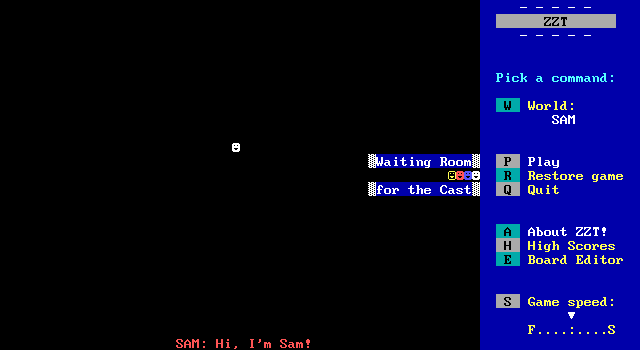
When the Worlds of ZZT project reached the one-year anniversary of its original Patreon launch, Dr. Dos sent out a celebration message that ended with this appeal:
"If you have a dusty old burned cd with backups of your Napster MP3s and your 1999 ZZT folder, save it! Send me that folder! Don't worry about filtering out games already being preserved. Together we can recover games both lost and forgotten. We can share our crude attempts at game development from when we were children. Our countless incomplete masterpieces have value.
"But of course, sending a zip file of an old folder is helpful, but it might not be as fun as also compiling a journey through your own ZZT worlds, giving them context and meaning. Share those grandoise plans for ZZT games written on a notebook during 7th grade study hall that never even got started. Share your history with us so we can all get a better understanding of ZZT's own history."
It is out of my deep support and admiration for the Museum of ZZT that I am heeding this appeal.
Before that message went out, back when I first went through the list of games the Museum had archived and saw that most of mine were not included, my first reaction was immense relief. My old games are awful and embarrassing, and the thought of anyone else seeing them today mortified me.
I could have continued to not say anything, kept my old shame to myself, and escaped the Museum's notice. I could have been free.
However, something about the earnestness of that message struck me. Dos is right; even the bad newbie games and failed demos are an important part of the history of both ZZT and its community. I was a forum regular for a time, and I can confirm that we all had our imaginary masterpieces we were working on, most of which never happened. Mine was going to be an ambitious remake of my first-ever game. Thus, the old version (which was terrible) and the new version (which ultimately never existed) became a part of the community's conversation, if only because I was in the community and this was that thing I was always working on.
Besides, Dos posted Virus 302 and School ZZT, so I have no excuse.
Therefore, please accept my gift to the Museum of ZZT: a closer look at Adventure of Sam. (The original. I may cover the sequel and aborted remake in future articles.)
I am so sorry.

From the beginning, this game does not look hopeful. Rather than an artful title logo, or even an ugly one, the title screen is a cutscene. Sam walks down from the top and introduces himself, then calls the rest of the cast to come forward and introduce themselves as well.
This was a direct rip-off of Tomas Guinan's "Sewers of ZZT," which I was hugely into at the time. Sewers has a title screen consisting of a silly cutscene with its cast as well. In retrospect, it probably wasn't a good design choice in that game, either. However, younger me must have thought it was the greatest thing ever, since I proceeded to make the same thing in my game only with far less competence.

For example, I wasn't familiar with the #cycle command, which changes an object's speed. Sewers' title screen has characters briskly running into frame to do their zany antics, and even that is insufferable by modern sensibilities. In Adventure of Sam, they walk halfway across the screen in the default cycle of 3, which takes forever.
While we're waiting for this journey to complete, I would like to mention one positive about this experience. Primitive as this game is, and embarrassing as it is to look at now, it at least serves as an unintentional time capsule for whatever I was into during its development. For example, thanks to me stealing its title screen concept, you now know about Sewers of ZZT! (You probably shouldn't play that one either, though.) Similar references are everywhere in Adventure of Sam, which is why Dr. Dos's appeal made me agree to cover this game. He's right; it is a part of ZZT's history, and mine.
At last, that character reaches the middle of the screen, says "I'm the Guard Captain!" and waits a few spaces south while the next cast member comes forward. This was totally worth the wait.
The red character is the King, who introduces himself in a similarly excruciating process. After that, the blue fellow is... oh, dear.
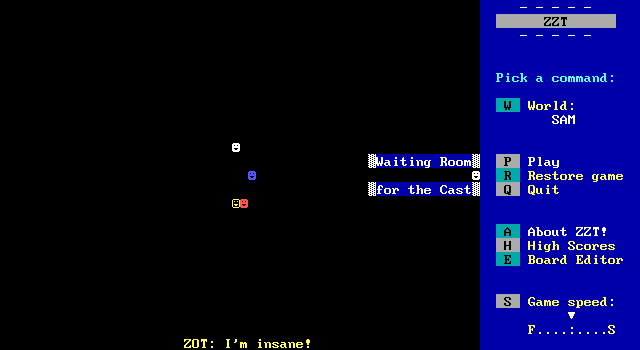
Zot is a stock caricature of a crazy person, and by that I mean he's basically GIR from Invader ZIM (before Invader ZIM existed, so Zot at least isn't a rip-off.) Expect any scene with him in it to be full of the kind of goofy "random" humor you can only find in a game made by a teenager.
Needless to say, this is not a good portrayal of mental illness and I am very sorry for everything about it. Let's move on quickly.
After a brief exchange in which Zot almost forgets his name, the final character emerges, then takes position alongside the others without saying a word.
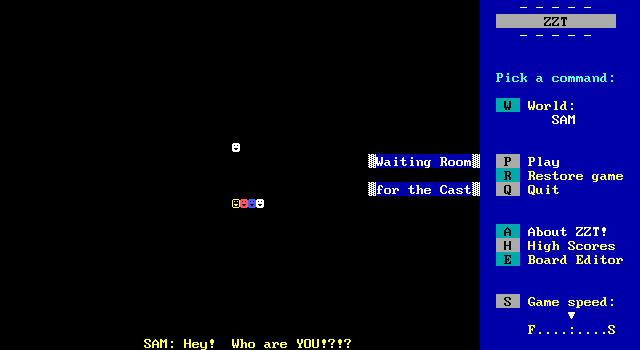
The other character (helpfully listed as "Guy") respond's to Sam's question with "I'm the hero of this game! Who are YOU?" Sam takes offense to this and promptly shoots his impostor, because that is always the appropriate response in games like this. Sociopathic player characters and author avatars played for laughs were fairly common back then.
The title screen then loops between "(Adventure of Sam)" and "(Press P to play)" messages until the player does so.
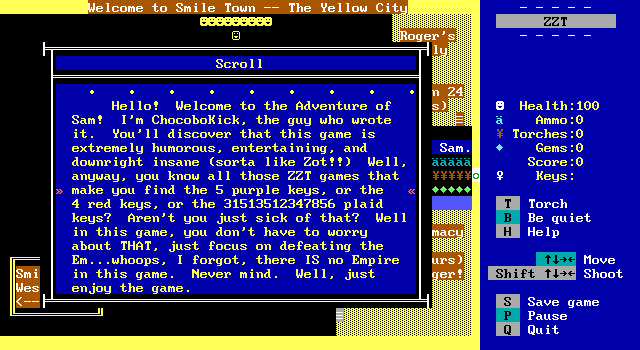
The game proper begins with a scroll, and wow is there a lot to unpack here.
"I'm ChocoboKick, the guy who wrote [this game]," the scroll begins, a statement which is now wrong twice in the same sentence. The part about me writing this game is still true, though, unfortunately.
Adventure of Sam proudly proclaims its superiority over boring old "Collect the 5 purple keys" structures by instead offering... literally nothing. It was about to say something about defeating the empire, but apparently there is no empire in this game. Some ZZT games give the player their entire quest in the starting scroll in the form of "Go stop the evil wizard" or the like, but Adventure of Sam gives you the starting objective of "Just enjoy the game."

ZZT community style guides strongly discourage the yellow normal wall borders that new boards come with in the built-in editor, to the point that a major selling point of KevEdit is the fact that it generates its boards without them. Conventional wisdom on why yellow borders are so unpopular is because they're garish and ugly. Young me missed that part of the lesson, and thought the hatred was solely because it was lazy programming. If a room has yellow borders, that means the programmer made a default board and left it like that. As long as I changed them to something else--anything else--then I was putting effort into it, and therefore it was okay. This was the design philosophy behind Smile Town, the Yellow City, a hideous mess of brown text and yellow blocks that are supposed to be buildings, all tied together with yellow solid wall (not normal wall) borders. See? I'm a good ZZT programmer.
I will admit that the gag with the dueling store signs still makes me chuckle, though.
On the top of the screen are guard captain and his guards, none of which say anything particularly interesting. The person guarding the stash in that blue area to the right will let Sam through with no difficulty--those goods are reserved for him, after all. The green door to the right is locked and impassable for now.
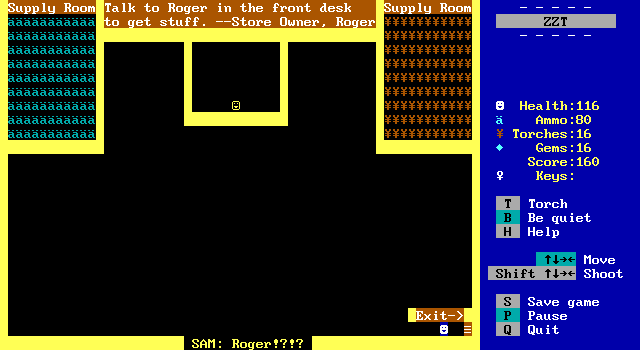
Roger's supply store is big and empty, and the player can't actually buy anything here. Instead, there is a slow dialogue exchange between Roger and Sam. In ZZT, outputting a single line of text makes it print at the bottom of the screen, in flashing colors, without pausing the action on the rest of the screen. Typing a several-line paragraph will have the game stop and print it all in a text box, like we saw in that scroll earlier. Sewers of ZZT had a tendency to output entire cutscenes to the bottom, one line at a time, with delays in between for readability as well as to keep the game from combining lines.
This makes
conversations
move
very slowly
and is
exactly
as fun to read
as it sounds.
Of course, young me still thought Sewers was the greatest ZZT game ever made, so if that's what Sewers did, that's what Adventure of Sam had to do.
Sam wants to know what Roger (whom he apparently knows) is doing in Smile Town, and Roger keeps botching his response until giving up and pulling out the game's script, reading from it that his home was attacked by the empire and--Oops, there is no empire in this game.
With that one final botch, Roger admits defeat. He has utterly failed to get his lines right, and therefore loses an inferred bet he and Sam apparently had that he wouldn't mess up if he were included in this game. For losing the bet, he pays Sam a good supply of Ammo, torches, and Gems. Alongside the stash from the first screen, the player starts out wealthy and well equipped by ZZT standards.
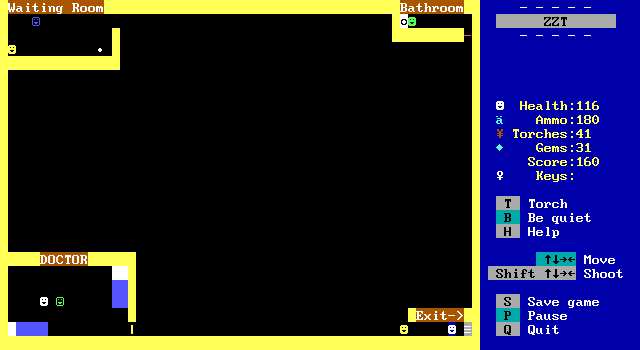
"Efficient use of board space" was not one of my younger self's strong points.
Pete's Pharmacy is more like a hospital or doctor's office of some sort. Even then it provides nothing for the player except flavor. Even Roger at least pays Sam if the player can sit through their entire conversation.
The receptionist asks if Sam has an appointment (which he does not) and then lets him in anyway because business is slow. The doctor's room and bathroom are both occupied, and neither door opens. The waiting room is full of people complaining about how long they've been waiting, which makes one question the receptionist's claim that business was slow. Sam actually does ask about this, and the response is "Well, there's only one doctor!" That doesn't really answer the question.

If I have to include a screenshot of every single board, then we're going to be here all day. I'm going to start fast-forwarding through the uninteresting ones. This includes the western half of Smile Town, which is mostly empty but for a store and a castle. The store is probably the closest young me came to an aesthetically pleasing layout for a shop menu, though devoting half the board to something one single shopkeeper object could do is kind of the ZZT equivalent of double-spacing and using a large font on your school essay to beat the page count. Even after counting the space taken up by the giant menu, half the board remains empty. "You don't have to use the entire board" was not a concept that young me understood very well.
The muttering and complaining old guy is there because Donkey Kong Country existed, and therefore Cranky Kong existed, and therefore muttering and complaining old guys were comedy gold.
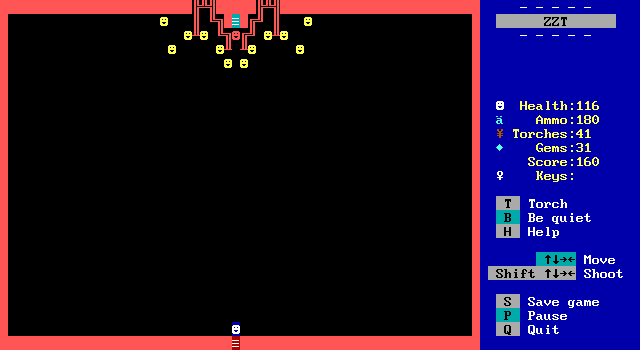
The castle, just in case it wasn't clear just how much I struggled to fill boards that had one important object.
The King tries far too hard to force "I'm the King!" as a catchphrase or running joke. We finally get to something approaching an objective, though: Sam asks the King for permission to go to the Centipede Plains, "Cuz that's where the bad guys are." He then goes on to show that it's because ChocoboKick programmed it that way, but believe me, I'm just as confused as you are. The only information the player knew going into this conversation was that this was not a game about fighting an empire.
The King gives Sam another 250 Gems, and I am feeling overly prepared at this point. Unlike many other ZZT games, it is perfectly safe to spend your Gems and buy supplies in this game. However, looking how the player starts out, why would you need to buy more of anything?

Oh. That's why.
The Centipede Plains consist of three boards full of centipedes, with the board shown here being the second. In case you can't imagine anything more fun than navigating this, this board was also dark before I cheated to get that screenshot.
I didn't purchase any additional supplies to get through the Centipede Plains, but I found myself ready to buy some more Health and Ammo afterward. Fortunately, the next town is just ahead. There's trouble, though!
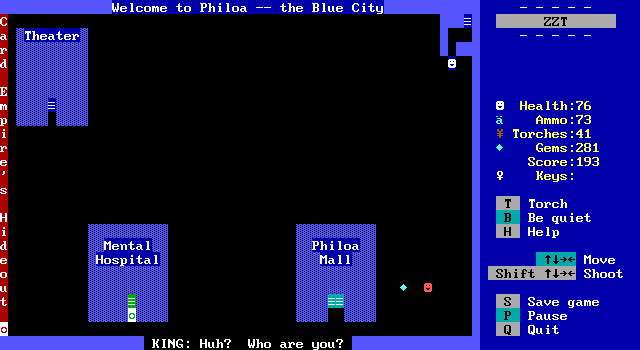
The cyan diamond introduces himself as Diamos, servant to Emperor Spade of the Card Empire. "But there is no empire in this game!" "There is now! Ha ha ha ha!" And with that, we finally have a plot.
Diamos kidnaps the King and takes him to their secret hideout, which I can only assume is behind that very obvious and clearly labeled door to the west.
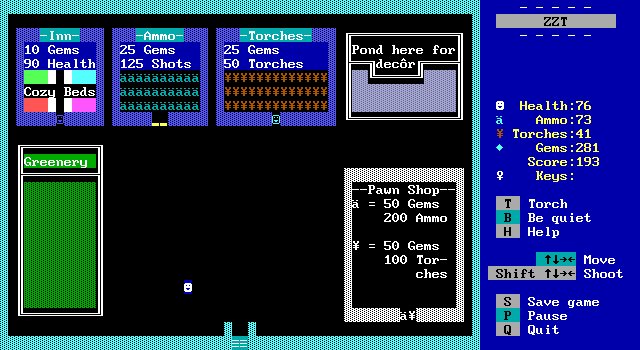
Saving Gems until Philoa was the right call. Not only are their prices better than the ones in Smile Town, but these may just be among the most generous deals I've ever seen in a ZZT game. I ended up with over a thousand Health, because ten Gems for 90 Health is absurd. I brought my Ammo up to just over 300, as well. 41 torches is probably sufficient. And I still have 121 Gems to spare!
There is a very easy exploit here, because I'm not very good at math. One can spend 50 Gems to buy 250 Ammo, and then sell 200 Ammo for 50 Gems in the pawn shop, keeping the extra 50 Ammo. This can be repeated as desired for infinite Ammo, which can be sold and converted to infinite quantities of all the other stats as well. I think we have more than enough already, though.
The theater plays a short cutscene (well, "short;" it's still printed one line at a time) in which the full Card Empire--Emperor Spade, Diamos, Heartius, and Phil the Club--proclaim that they've captured the King. Now they need to let Sam know, so that he can find their hideout, beat the bad guys, and save the day, because that's how it goes. Whenever young me painted myself into a corner plot-wise, I broke the fourth wall and had a character loudly proclaim that the next plot point is happening because that's what the plot says, now shut up. Not only did this get me out of any creative jam without fail, it was also unfailing hilarity that certainly never got old.
Nonstop wackiness like this is why I didn't want to release this game to the Museum without an article apologizing for it.
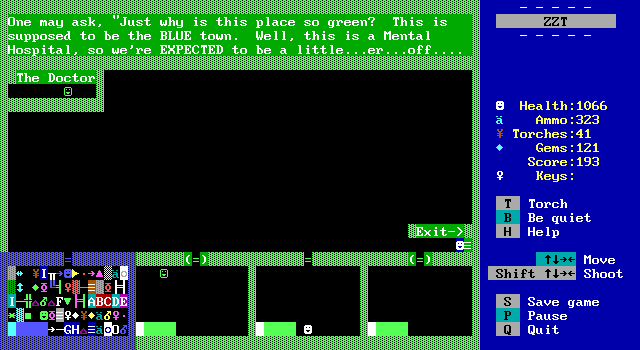
Actually, no, this is why I need to apologize for this game. Young me followed the "crazy people are funny" school of writing, which is why Zot's cell is full of wacky bric-a-brac. Writing this article is a constant struggle between how hard younger me wanted to push Zot versus how much older me hates this room and everything about it.
Of course, this is another moment that owes its inspiration to Sewers. There, the player raids a mental hospital and finds the game's author, Tomas Guinan himself, imprisoned for playing too much ZZT. The player character boldly proclaims that ZZT isn't a crime (though I would argue that games like this should be) and frees Tomas, who joins the player's party in gratitude. This not only inspired me to have a mental hospital scene in my game, but also to have the author himself ("himself" at the time) appear as a character, which we will see later. I'm sorry in advance.
For now, the point of this room is to talk to Zot and get the red key behind him, which unlocks the door to the Card Empire's secret hideout. Zot sings the Meow Mix theme, declares that the red key is his beloved possession and that he would take it with him even if he were to be released, and then promptly leaves it behind when the doctor releases him. LOL, so random ^___^
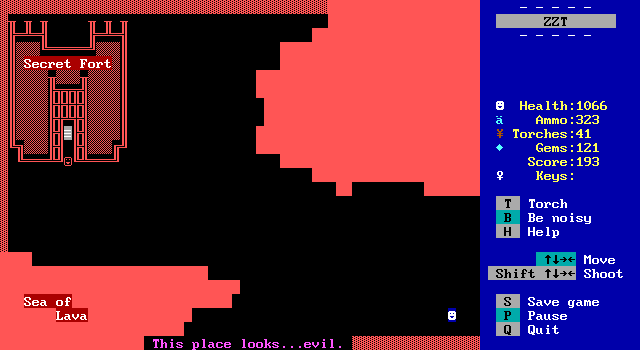
The secret hideout exterior is one of the more decent looking boards seen so far. It is even possible to interact with the lava; the edges are not solid walls, but rather objects that have Sam cry out how hot it is when touched. (Every inaccessible tile behind them is a solid wall, though.)
There's an ogre guarding the entrance, but the when you talk to him, he lets you through because the Card Empire never paid him anything, anyway. He then walks forward into the lava, where he falls in and dies. Whether that was an accident or suicide is unclear, but Sam cracks up laughing over it either way. As I mentioned before, 90s ZZT games are mean-spirited by default.
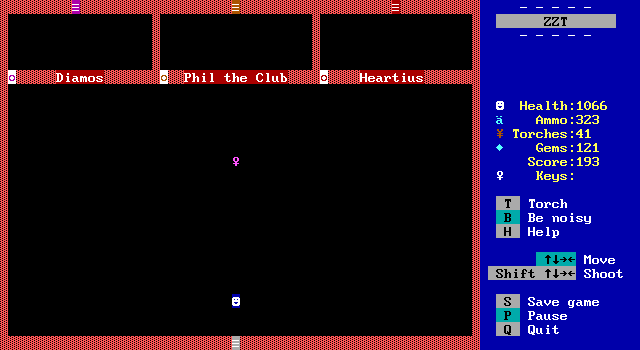
Emperor Spade appears just inside, and challenges Sam to defeat his men. He then leaves behind a purple key, which unlocks the door marked "Diamos." It's boss rush time!
Once again, way to fill up the board, younger me.
Diamos' lair has a board filled with Ruffians, which probably would have been more appropriate in Phil the Club's lair. Diamos himself is an uninteresting gimmick boss which requires the player to touch a "Diamos' Weakness" object tucked in the corner of the room, which will defeat Diamos and end the battle.
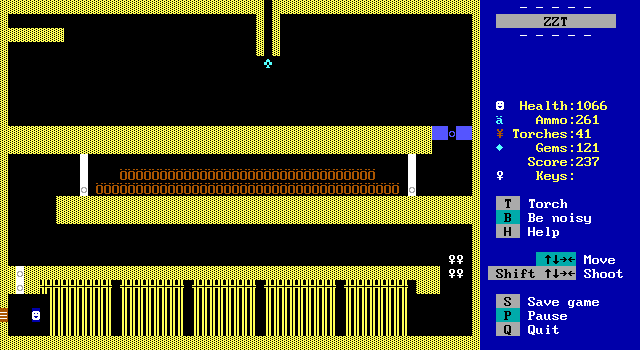
Moving on, Phil's lair has a blinkwall field, some bears, and far too much walking back and forth to unlock all the doors considering that the player can only carry one white key at a time. With the close proximity of the bears to the locked door, and with how bear AI works, there is no way to fight them without taking a few hits.
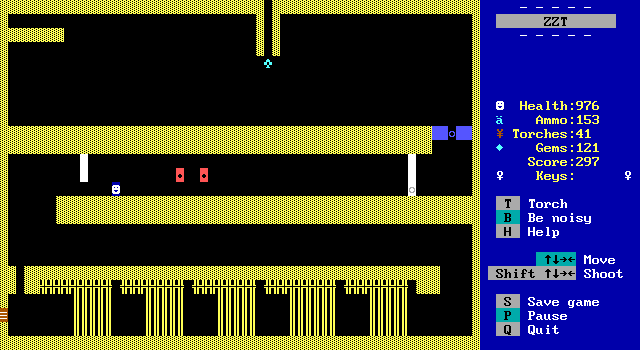
ZZT, or at least Adventure of Sam (but what I would have done differently in this game, I have no idea) has an interesting glitch when firing rapidly into a crowd of charging bears. Sometimes, they turn into a sort of error tile instead of dying properly. It normally has the appearance of a black wall (making it invisible in this screenshot,) but pressing or shooting into them occasionally turns them into red tiles with black holes in them. Either way, they function as walls, and cannot be moved or shot though. This makes it very inconvenient when a bear turns into one halfway through a line of them, forcing the player to walk around it (and thus be open to more hits) to continue fighting the bears behind it. It is very fortunate that Health is so plentiful in this game.
A note from Dr. Dos: What's happening here is because ZZT's fill tool sometimes just places things on top of what's being filled rather than replacing it. Lots of these bears have objects underneath them which don't have stats. When the bears move, the object pops back up to the main layer, and without any stats uses the default character which is an empty char 0. Sometimes instead the bears are shot before moving and the object is brought back to the top, and takes the stats that the bear had leading to char 8 characters that match the bears' sensitivity value of 8. ZZT is weird.
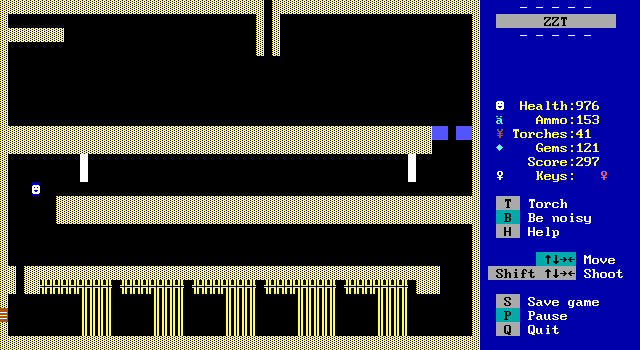
On the way back out (Phil the Club is another gimmick boss, where the room is full of ricochets and the player has to make Phil shoot himself,) the red glitch walls are no longer red or visible, though they very much are still present.

Heartius' lair is a less competent version of the three lakes board from Town of ZZT.
Heartius himself is the easiest or hardest boss so far, depending on whether the player exploits a programming oversight and shoots him during his opening pre-battle monologue. If the battle gets started, Heartius slowly walks toward the player while throwing an unending barrage of stars. I really am not sure how one is meant to fight back against that, so I reloaded and killed him before the battle started on my second attempt. Sam calls him a wimp upon defeating him, though he really isn't if the player fights him fairly.
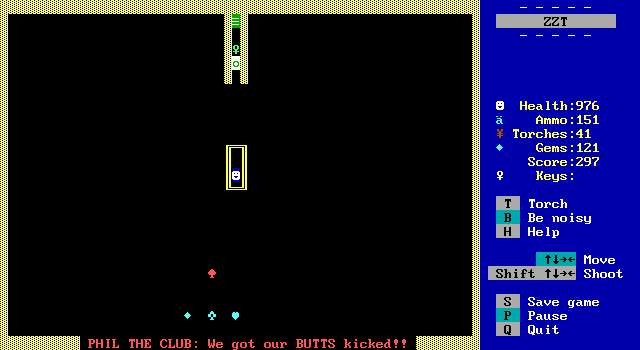
Now here's a well-made board.
After beating all three of the Card Empire's generals, they gather and report to Emperor Spade, each explaining why they lost. Emperor Spade concurs with Sam's earlier assessment and calls Heartius a wimp, and now we see the justification: the other two lost because of the gimmicks that worked against them (Diamos' weakness being clearly labeled and placed in the corner; the ricochets in Phil's room) whereas Heartius only has the comparatively unimpressive excuse of, "He shot me."
Spade's solution was to trick Sam into entering this board, with that wall around where he appeared. Now he's captured. Another very long one-line-at-a-time cutscene ensues, and the player can't even leave this one. Truly, this is the worst possible fate for our unfortunate hero.

No swearing in a family game.
I was hugely into Final Fantasy 6 at the time, and therefore I had the perfect minced oath that totally works and in no way sounds ridiculous.
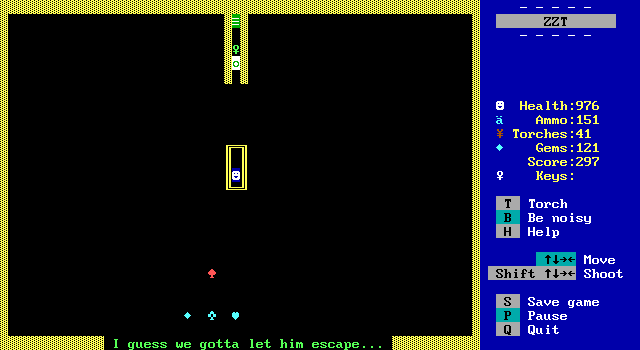
The Empire immediately lets Sam go, for the same reason they told him about their plot in the first place: that's what villains are supposed to do. For an unauthorized evil empire that appeared in a game that wasn't supposed to have them, they are very considerate in regards to following the rules, even the ones that require them to lose.
However, letting Sam out of the cage doesn't let him out of the board. The only exit is behind a locked green door, and the green key itself is also behind the door. It would appear that Sam remains stuck here.
"Just one thing, though," Emperor Spade adds before they all teleport away. "Diamos, make SURE you don't drop that Key!"
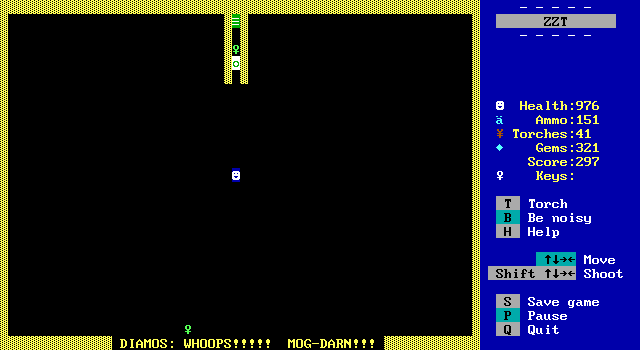
Classic.
With Diamos' green key, Sam unlocks the green door and escapes, taking the second green key with him. This unlocks that door from the beginning of the game, back in Smile Town. The green passage at the top of the screen leads to Smile Town, even, so at least there's no backtracking.
Meanwhile, the King appears to be in another castle. Sam's quest continues.
In addition to the key, clearing the Card Empire's base also awards the player with an additional 200 Gems. It is tempting to return to Philoa to replenish stock, because having 150 Ammo after the secret lair feels low by Adventure of Sam standards. However, that would involve going through the Centipede Plains again. The Smile Town store's prices aren't quite as good, but that's another "by Adventure of Sam standards" statement: one can still buy 150 Ammo for 30 Gems here, out of the 200 Gems that Sam has just received. In fact, after some shopping, I now have just over a thousand Health, 600 Ammo, and 40 Torches (no one ever uses Torches,) and I still have almost 200 Gems to spare.
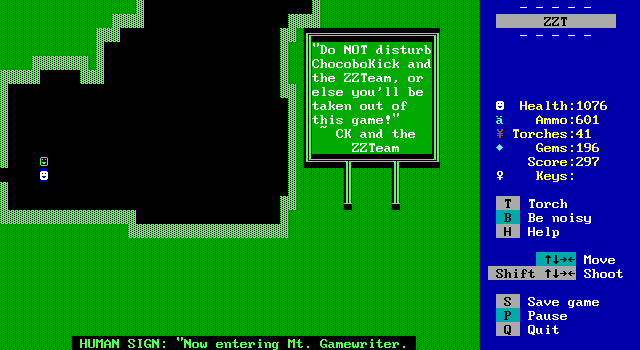
(The second half of the human signpost's line is "Stay out or else! ~ChocoboKick")
This game already had very little in the way of a fourth wall, given the card empire's behavior, but beyond the green door in Smile Town is the entrance to Mt. Gamewriter, home of ChocoboKick himself. For the purposes of this article, I will refer to ChocoboKick in the third person, and as male, as that was how I saw myself at the time. Psychologically, it also helps me to put a little distance between my current self and... this.
To avoid confusion, I also will try to avoid the "CK" abbreviation even though the game uses it freely, since my current name is Celine Kalante.
I need to explain all of this and have this established so that I can reach my central point here, one which the reader likely has already concluded from the above screenshot: ChocoboKick is a massive, massive jerk.
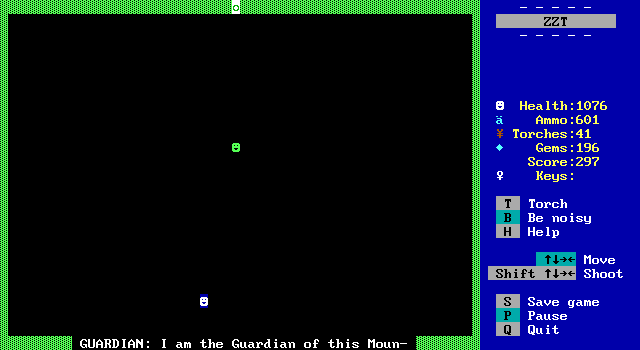
Aside from the signage, one can tell that neither ChocoboKick nor the ZZTeam want visitors from how the first room past the entrance is a boss. The Guardian fights much like Heartius: unfairly, with far too many stars, but the player can skip the fight by opening fire during the pre-battle monologue.
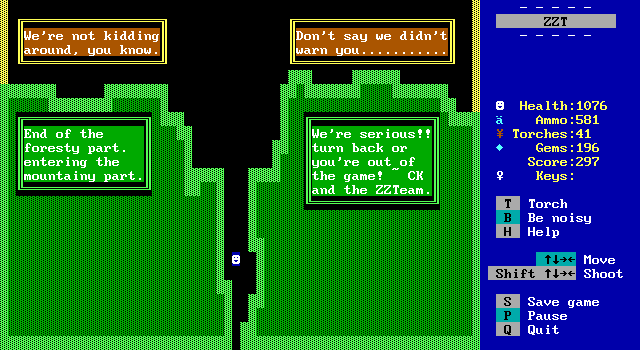
How friendly. For a bonus challenge, try to discern the order in which the player is meant to read these signs.

Speaking of inferior three lakes rip-offs. There is very little challenge here, because a complete lack of shooting restrictions on this board lets the player fire against the spinning guns. Player bullets tend to overwrite incoming bullets, so one can create cover underneath their own shots like some sort of bullet umbrella (made of bullets, protects against other bullets.)
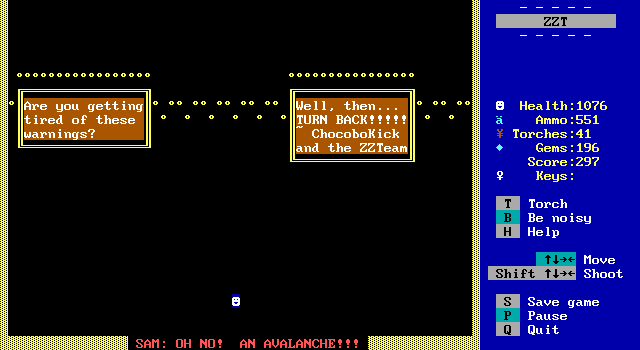
For how much Sam tries to sell it with his panicked reaction, this is the saddest "challenge" in the entire game. A single uniform line of rock-like objects marches down the field at a slow, leisurely pace. They might do damage if they somehow hit the player, but given how easy it is to take cover behind the ZZTeam's own signage, the only way one could ever take a hit here is by doing so on purpose.
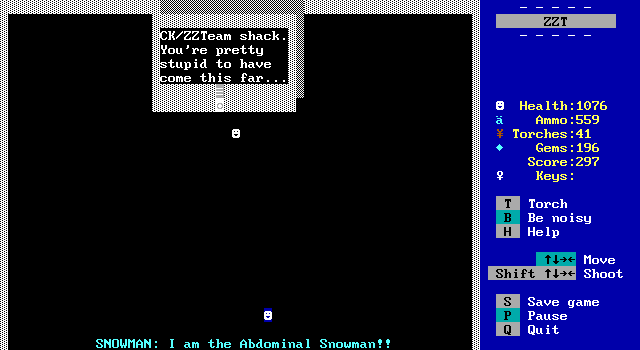
Sam tries to correct this boss's name, but no, the misspelling is deliberate. The Abdominal Snowman got 5 Day Abs and did it 17 times, you see.
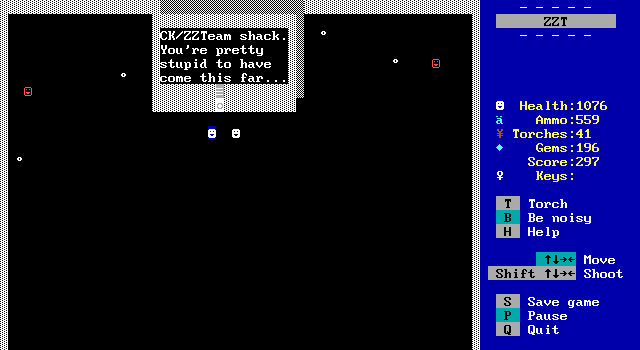
The player cannot shoot here, and the Snowman himself makes no effort to move, shoot, or fight back at all. Instead, he summons two minions that shoot at Sam. The solution is to stand next to the Snowman to trick the minions into shooting him, which is easy to do.
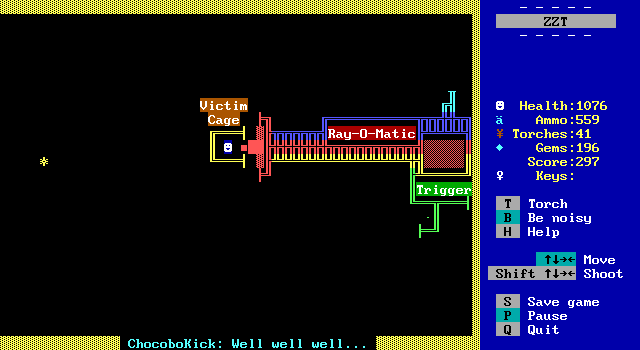
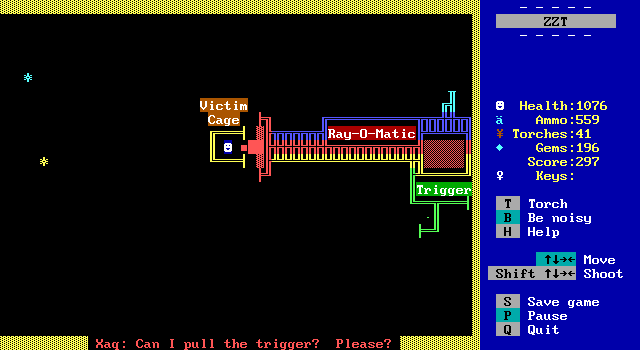
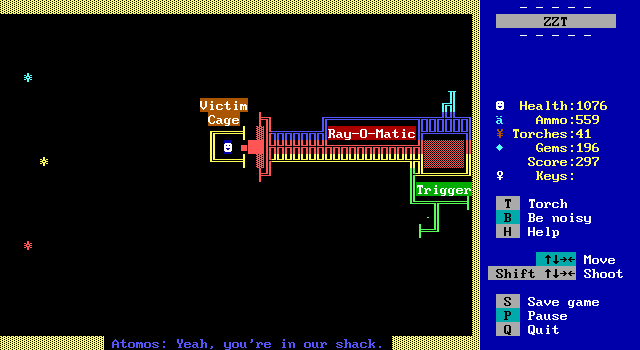
Meet the ZZTeam. As you can see, they are very cuddly and approachable.
Xaq is, as of this writing, the longest-standing friend I've ever known that I still talk to today. We've been in and out of various fandoms together, we've grown and changed as people, but we've always been close. He is the only person I know who both 1) was around long enough ago to have appeared in Adventure of Sam, and 2) is still here today and able to look back on this appearance with me in this Closer Look article.
By contrast, I have no idea whatever became of Atomos. I hope he's doing well, wherever he is.
The player was never given a reason for why Sam must scale Mt. Gamewriter, and its occupants have done nothing but discourage the notion. Sam intuitively seems to know, though. It turns out that Sam is here to warn the ZZTeam about the Card Empire's unauthorized appearance in this game. Name-dropping them spares Sam from his otherwise certain doom, as the ZZTeam have an apparent history with the Empire. "I thought we exiled them to Dimension-W," Atomos laments. With Sam's brilliant retort of, "Well, apparently they're back," the ZZTeam has someone to go after besides the player. The cage surrounding the Ray-O-Matic dissolves, and the player is free to follow the ZZTeam west.
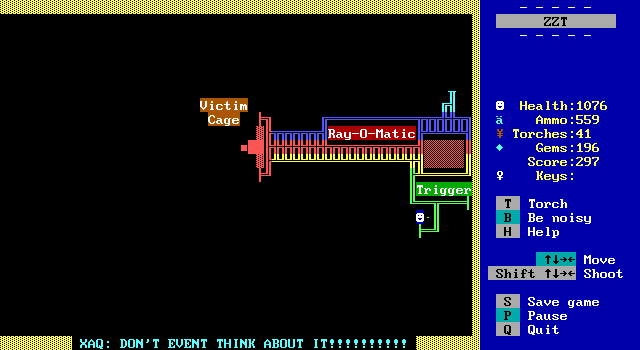
Aww.
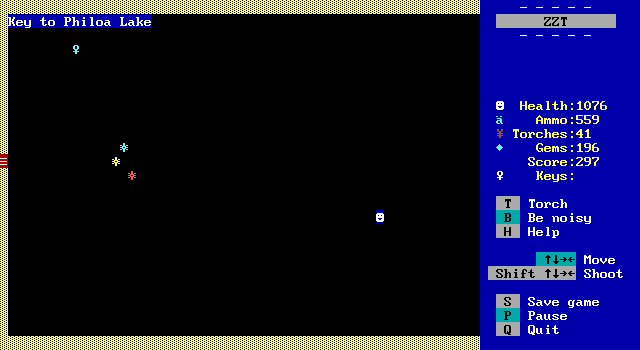
Maybe yellow borders are just a sign of laziness, after all.
The passage drops the player off at the base of Mt. Gamewriter (where the "human sign" was.) Since the next destination is Philoa Lake, that means we really do have to go through the Centipede Plains again.
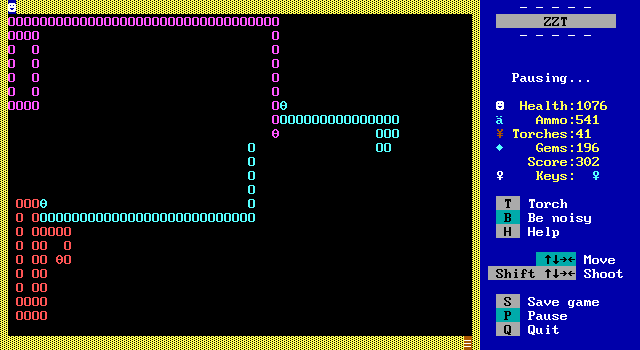
This is highly unfair. Not that the 30 Health I lost on this board particularly matters, though, all things considered.
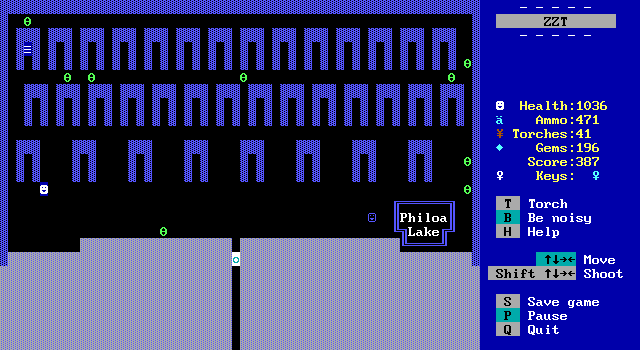
Philoa Lake does indeed have a locked cyan door leading further south. I had forgotten about it, so the label in the ZZTeam's shack was a rare instance of them being helpful.
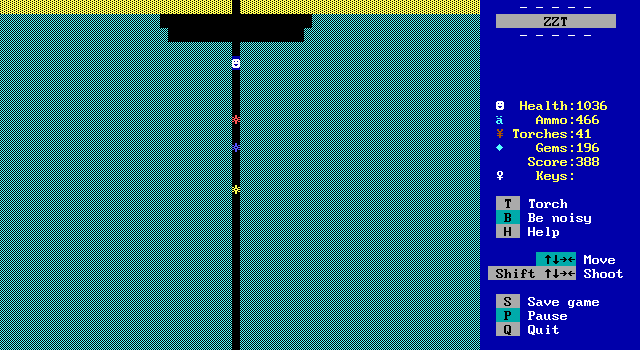
The lower portion of the lake (which Atomos identifies as the legendary Sea of Aesor) looks nothing like the upper. I recall going with breakable walls instead of actual water on this board because I needed objects to match them for a special effect: the path south from that clearing is not there until ChocoboKick miraculously parts the sea. This was done by having objects that look like the surrounding water tiles, which are all set to disappear as soon as ChocoboKick sends them the signal. A newbie developer using ZZT's default editor in the days before STK wouldn't have been able to recreate anything that looks like a standard water tiles using objects, though, so the entire sea was reduced into something that the objects could replicate.
As an aside, I would like to call attention to the code here. Not for the disappearing sea tiles, but for the rest of the cutscene. This is what ChocoboKick's code looks like, and it is fairly indicative of what all of the code in Adventure of Sam looks like:
CK: They built their castle on the other
#IDLE
#IDLE
#IDLE
#IDLE
#IDLE
#IDLE
#IDLE
side of this ocean.
#IDLE
#IDLE
#IDLE
#IDLE
#IDLE
#IDLE
#IDLE
SAM: I thought this was just
#IDLE
#IDLE
#IDLE
#IDLE
#IDLE
#IDLE
#IDLE
Philoa Lake...
#IDLE
#IDLE
#IDLE
#IDLE
#IDLE
#IDLE
#IDLE
Atomos: You didn't know that on the
#IDLE
#IDLE
#IDLE
#IDLE
#IDLE
#IDLE
#IDLE
other side is the legendary Sea of Aesor?
#IDLE
#IDLE
#IDLE
#IDLE
#IDLE
#IDLE
#IDLE
SAM: How disillusioning...
#IDLE
#IDLE
#IDLE
#IDLE
#IDLE
#IDLE
#IDLE
CK: OK, then, let's dry up a path!!
#IDLE
#IDLE
#IDLE
#IDLE
#IDLE
#IDLE
#IDLE
#send Water:Do
#send Xaq:Do
#send Atomos:Do
/s/s/s/s/s/s/s/s/s/s/s/s/s/s/s/s/s/s/s/s/s/s
/s
#DIE
• • • • • • • • •
There is a lot to unpack here, but the most obvious glaring issue is the seven #IDLE commands between each line of text. As I mentioned earlier, this was to make sure that the conversation would print to the bottom of the screen rather than in a text window. However, any experienced ZZT programmer should rightly question why I didn't use /i for that, which I could have done on one line for all seven cycles ("/i/i/i/i/i/i/i") rather than using #IDLE commands that each require their own line. I believe I tried that once, early on in this game's development, and I must have had a typo or something because my attempt at an /i direction did not work. Rather checking my own code to see if I had entered it wrong, I assumed that /i itself was an invalid command, and I didn't know how else one were supposed to do that, so I defaulted to using #IDLE. It was the one I knew how to do.
Thus, if the reader is miserable attempting to follow along with this game's glacial conversations, and wants to feel any better, take solace in knowing that each one was just as miserable for me to write.
It is a very good thing that the directional commands worked on my first try, though. I can't imagine how the end of this block of code would look with that many individual #GO SOUTH commands.
I mention all of this because it brings up an interesting design philosophy behind ZZT, especially when compared to other programming languages. Experienced ZZT programmers would use /i instead of #IDLE (and even more experienced programmers would realize that this is a bad design decision and let the text go to a text box,) and aside from being easier to type, the main reason for this is compression.
In direct contrast to other languages, which are all about white space and readability, coding in ZZT is an exercise in how to do things in as few characters as possible in order to circumvent board and world file size limits. /i versus #IDLE is but one of many examples of this practice. Another can be found in the messages to other objects at the bottom. "#send (name):(flag)" makes it more obvious to someone outside of ZZT what that line of code actually does. However, "#(name):(flag)" without the "send" works just as well. In practice, this meant that no experienced ZZTer ever included the "send."
The community took this to extreme lengths as their games increased in size and complexity. The ability to have non-compiled comments in the code is a feature that ZZT supports, but one that (barring commented-out labels for #restore shenanigans) no one ever used. People regularly gave their objects, labels to jump to in conversation trees, and so on names like "a" because "Shopkeeper" and "NotEnoughGems" take extra space. We even discovered that putting a directional and regular command on the same line ("/i#end" for example) actually worked, and saved... what... two bytes? by not having a line break there, and so this was considered a good practice that all aspiring ZZT programmers should do.
I find Adventure of Sam's code fascinating because it is bad code, but mostly for reasons that aren't apparent outside of ZZT. Everything a ZZTer would do to fix it (using /i, removing the unnecessary "send", etc.) is something that other languages' programmers would think makes it even worse.
Anyway, south of this board is a fork, with exits west and even further south. I know from memory that south leads to the game's final act, so instead I head west for our last friendly town.
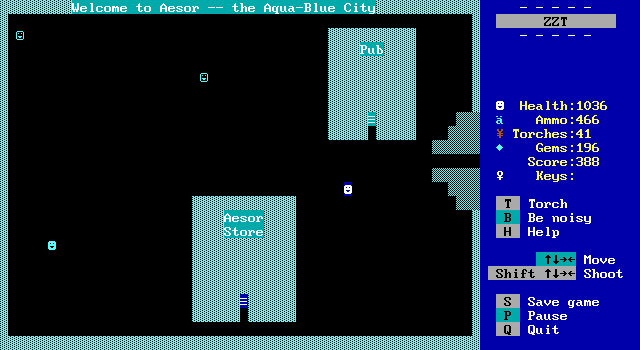
There isn't much to do in Aesor. However, given how little content I spread over entire boards, perhaps cutting the unnecessary extra locations was for the best.

These prices are still far more generous than several ZZT games of the era. The bulk deal on Ammo is only slightly worse than the Armory's exchange rates in the Town of ZZT, where 35 Gems can buy 105 shots (but one would have to go through 35 iterations of purchasing them 1 Gem/3 Ammo at a time.) The rate for Torches is slightly better (the Armory only offers a direct 1:1 equivalency there) and the player cannot purchase Health in Town.
By Adventure of Sam standards, though, these prices are terrible. Since Aesor and Philoa are only three boards apart, it is worth backtracking and spending the rest of my Gems in the Philoa Mall.
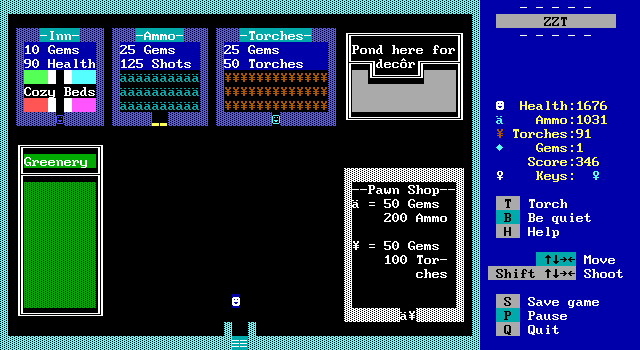
Much better. (The Score is lower because I had to reload and replay that section for unrelated reasons.)

Back in Aesor's pub, the ZZTeam seems to have had the same idea to take one last rest break before the final area. For some attention to detail, ChocoboKick has what I assume is a big pile of leafy Greens in front of him, because he is a chocobo. Xaq has a mug of something, and I have no idea what Atomos is consuming.
That red circle in the lower-right table is an abandoned yet full and still good mug of beer, which the player can drink for 50 Health. I'm a little surprised that I was so uncomfortable with swearing in this game that "#$^!#" and "Mog-darn" were acceptable alternatives, yet I saw no problem with alcohol references.
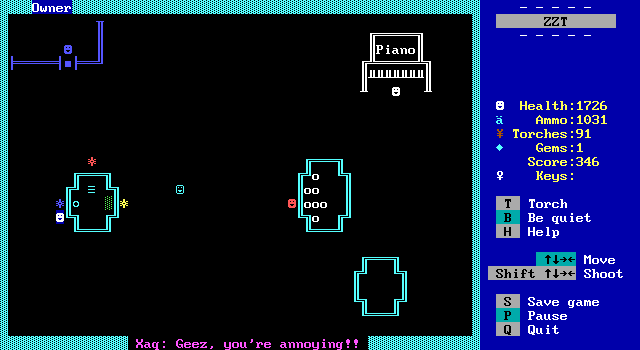
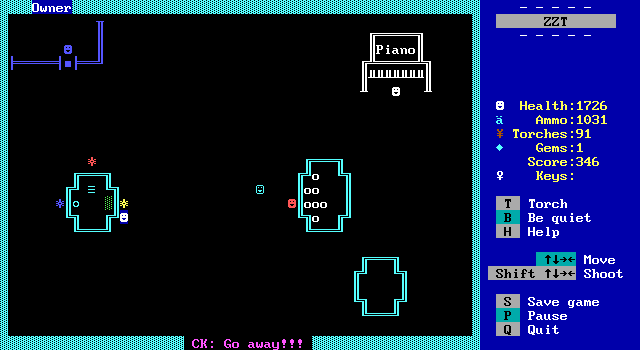
The ZZTeam is begrudgingly working alongside Sam to deal with the Card Empire, but they see it more as them solving the problem while Sam is little more than an obnoxious tagalong. They are openly hostile to him, to the point that only the only reason they haven't murdered him yet is because of their common enemy. Well, that, and because Sam is the main character, and ChocoboKick wisely notes that the game would end if he were to die.
This is an interesting observation to make considering that ChocoboKick is a younger me, but I find myself rooting for the Card Empire at this point. Other than kidnapping the King, the Empire's only on-screen crime thus far has been existing in game in which they aren't welcome. Sam is close to being guilty of the same sin, if the ZZTeam's attitudes toward him are any indication. Despite what I would consider to be persecution at the hands of the ZZTeam, the Empire has obediently followed the rules of how plot structures are supposed to work in games like these, up to and including letting Sam go because they were at the part where he was supposed to escape. By contrast, the ZZTeam rudely and arrogantly does whatever they want in this game, are this close to killing Sam, and they're supposed to be the good guys.
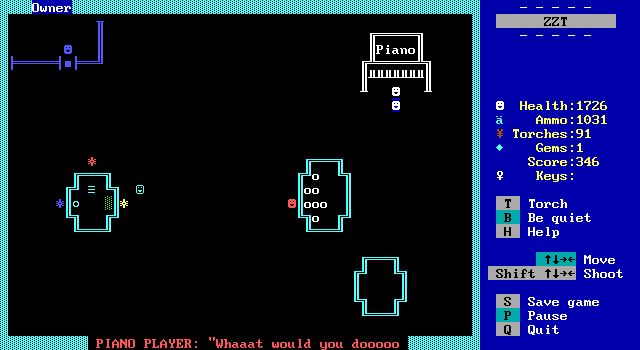
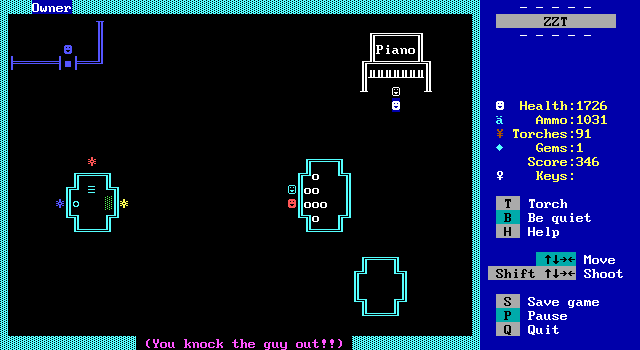
Comedic Sociopathy is not entirely restricted to the ZZTeam, however. Sam is capable of some jerkish behavior himself, such as knocking out a piano player for playing "With a Little Help From my Friends" or, as I knew back then, the theme song from "The Wonder Years."
Take-thats were fairly common in ZZT games at the time. Most authors were edgy teens who hadn't quite grasped the concept that even if a particular form of entertainment wasn't their thing, it was still someone's thing. There was no such thing as "Perhaps I am not the intended target demographic for this song/movie/show/etc." Instead, anything not to their tastes was a form of pure evil that needed to be destroyed. Killing Barney the Dinosaur was an entire genre, for example, with several ZZTers getting in on the act.
The Wonder Years theme is a rather deep and obscure thing to hate, though. My only explanation is that reruns must have been airing regularly around the time my family normally ate dinner, which meant that I'd have heard that song so many times that I eventually became sick of it.
The concept of Sam encountering an NPC that annoys him and immediately rendering him unconscious is yet another nod to Sewers of ZZT. Both games include an unimportant side NPC to which the player character reacts violently after speaking to them. However, Adventure of Sam's version is (surprisingly) far kinder, as Sam "only" knocks someone out for playing an annoying song. In Sewers, the player character murders someone for being gay. (Yes, really. There are a lot of things from my ChocoboKick phase of which I am not proud, but to my credit, even back then I was a little uncomfortable with Sewers doing that and had the good sense to tone my version down.)
Moving on, south from the fork in the Sea of Aesor is the Forest of Tharios, with the Card Empire's castle beyond that.
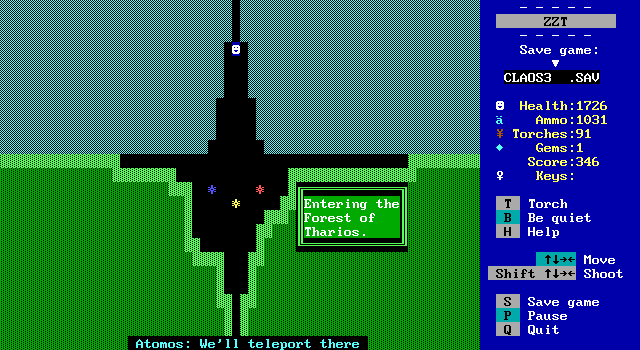
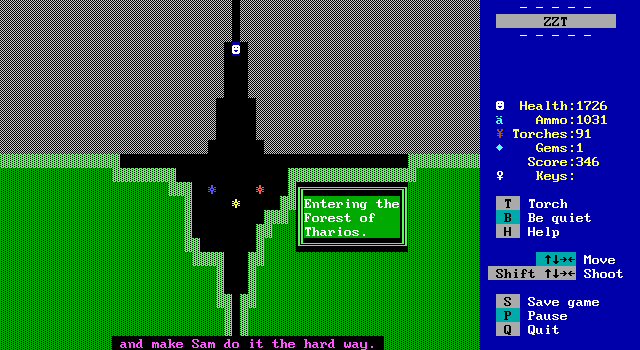
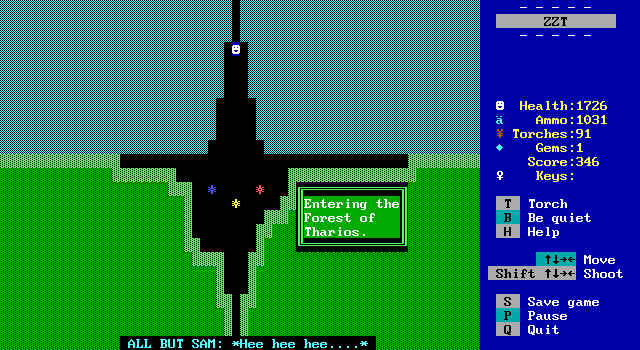
Thanks, guys.

Thanks to having access to bright green objects/walls and dark green forests, this is one of the more aesthetically pleasing boards in Adventure of Sam.
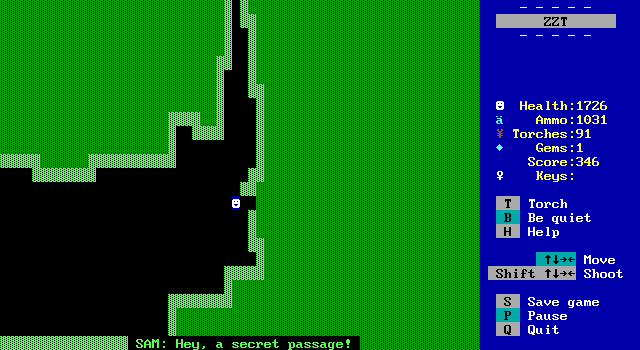
It also has a secret passage!
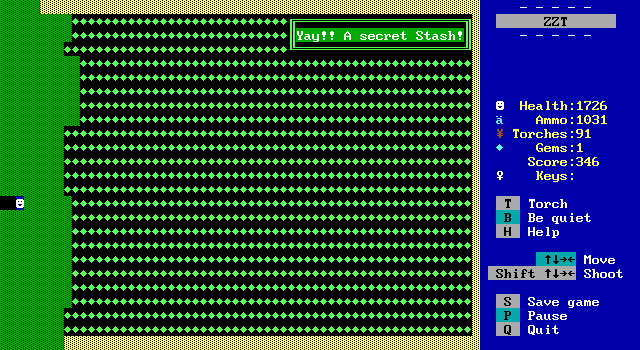
By the time I had joined the ZZT community, I already hated the original Adventure of Sam, and this was the screenshot I used in our community wiki article for it. It sums up almost everything wrong with this game in one convenient image: yellow borders, a field of Gems that is tiring and very much not worth it to collect, even the poorly-written text box that becomes useless if one does bother to gather all the Gems. All that's missing is something illustrating the ZZTeam's mean-spirited bullying.
I leave without taking anything, because I am fairly certain I have more than enough Health and Ammo at this point.
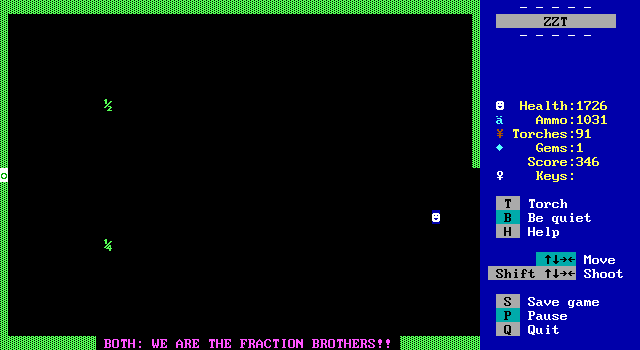
The Fraction Brothers taunt you, then descend into bickering and firing on each other over whose turn it was to say the "Prepare to die" line. They both kill each other before the player even has a chance to fight them. In fact, I put an invisible barrier around the two to prevent the player from shooting them prematurely, because I thought this scene was comedy gold and I didn't want anyone to interrupt it.
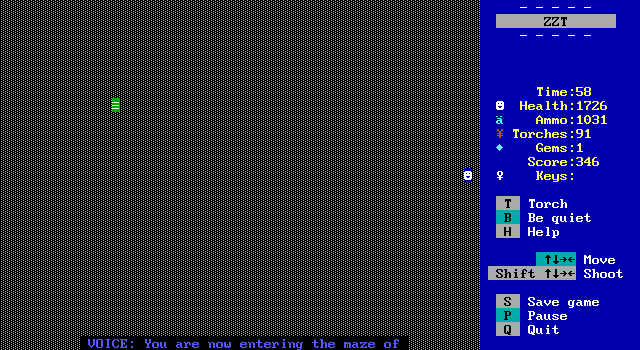
The next challenge is a Lost Woods type room with three exits (there's a wall preventing the player from going north) that lead back to themselves. The trick is to exit south to wrap back around and enter the board's walled-off northern area, which has the key to the door blocking the passage that leads to the next area. There's a duplicator slowly adding lions to the room, and shooting appears not to work for some reason (the player can shoot, and Ammo is consumed, but the bullets do not appear.) However, this is still a very easy challenge, even in darkness.
It takes me two Torches to get through this maze, and it is the last dark board in the game. I had 41 Torches before undertaking my final preparations in Philoa, and it now becomes apparent that I really did not need to buy 50 more. However, I had extra Gems, and it wasn't like I was short on Health or Ammo at this point.
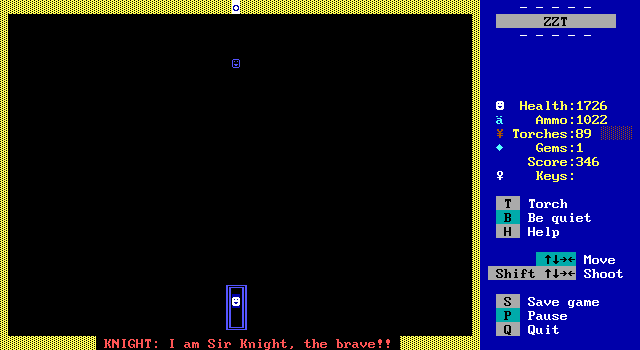
By this point, my bosses were about as inspired as the boards in which the player fights them.
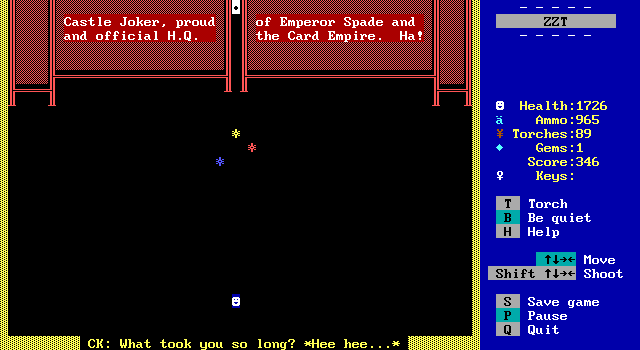
Finally, Sam arrives at Castle Joker, no thanks to the ZZTeam.

The running gag here is that Xaq desperately wants to kill Sam, but ChocoboKick (despite hating Sam every bit as strongly) recognizes that he is essential, and that Xaq can't kill him because that would end the game. It somehow never occurred to me that people besides me and my close personal friends might want to play this game, or that they might not enjoy being scorned like this as much as we enjoyed the scorning.
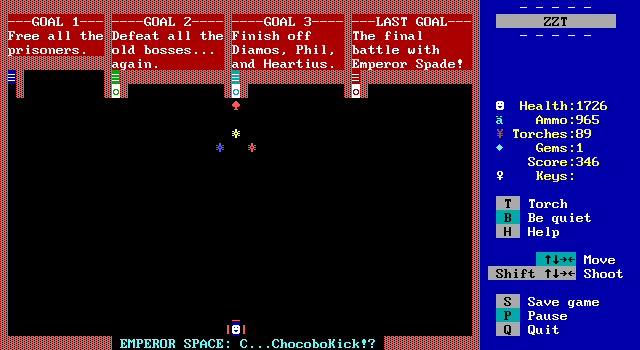
"Emperor Space" flees deeper into the castle, with the ZZTeam in hot pursuit. (ChocoboKick orders Atomos to free Sam before they take off.) The player has three "goals" to achieve before the final battle. The fact that the Empire's own signage spells them out like this proves that 1) they are still adhering to the rules in facing Sam, even as they defy the ZZTeam by existing, and 2) they are a lot more polite to Sam than the ZZTeam are.
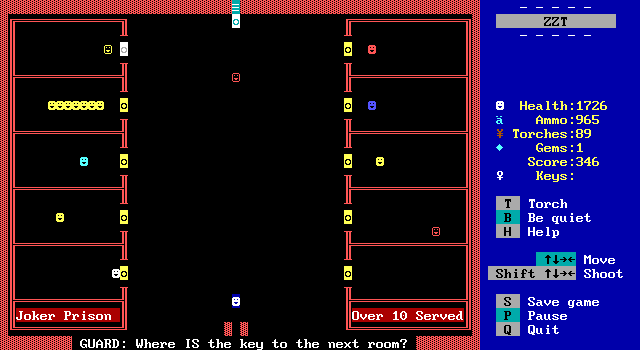
The prison guard seems to have lost the key to the next room, having sworn it was in his pocket. Before he can find it, he spots Sam and attacks. After being defeated, he drops a white key, so it was in his pocket after all.
Except that the white key doesn't unlock the door to the next room. It unlocks the upper-left cell, which belongs to the guard captain from Smile Town. He stole the prison guard's key, and gives it to Sam upon asking.
Other prisoners in this room include the Smile Town guards, the King, that impostor who thinks he's the hero of this game (he has the honor of being the second NPC Sam knocks out,) Zot, and "The Invizible Psycho" who was also in that seemingly empty cell in Philoa's mental hospital.
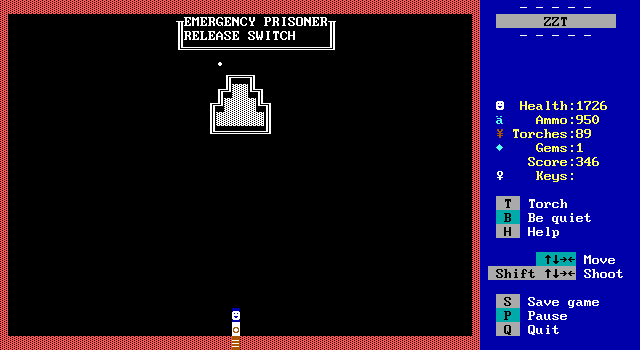
I made the passage leading out of this board a different color than the one leading in to prevent the player from spawning on top of it. I then placed the player's spawn point just north of the door leading back out, all in order to prevent them from leaving without throwing the prisoner escape switch (which also drops the key.)
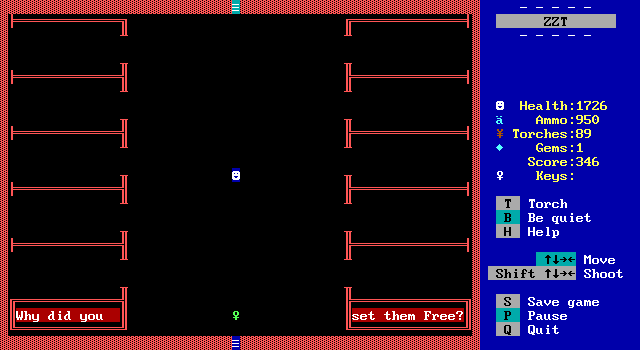
I did all of this because the "Freed prisoners" version of the prison room is a different board. I didn't remember having put the "Why did you set them free?" message in there, though.
In the SNES version of Dungeon Master (and possibly other versions, but that was the one I played,) there's a puzzle towards the end of the third floor. A weakened mummy with one hit point stands atop a pressure plate that's holding shut the door leading further on. The mummy and pressure plate are isolated on the other side of a pit, with a plaque nearby that reads, "THIS IS MY PRISONER. LET HIM SUFFER." The only way to free the pressure plate is to throw something across the pit, which strikes and kills the mummy, removing it from the plate and thus opening the door. However, as soon as the player does this, several monsters spawn, along with a new plaque on the nearby wall which reads, "YOU WILL REGRET THAT."
This terrified me when I was younger. It also convinced me that it was the wrong solution, since I remembered there being far too many monsters for the game to reasonably expect any player to fight their way through. Due to graphical limitations, it sort of looked like the mummy was on the same tile as the pressure plate but not actually standing on the pressure plate itself. Therefore, I believed the solution was to find something I could throw that would land on the plate without harming the mummy, as the mummy's death is what causes the floor itself to take revenge.
The actual solution really is to kill the mummy and fight your way through the monsters. I misremembered how many of them there were; the crowd is quite manageable. I was simply unprepared the first time I tried it. Since I ruled out that option on subsequent attempts, and was stuck searching for any solution that wasn't that, I never did beat Dungeon Master.
The point of this story is that the "Why did you set them free?" message on this board made me jump in my seat a little. Good job scaring me, younger me.
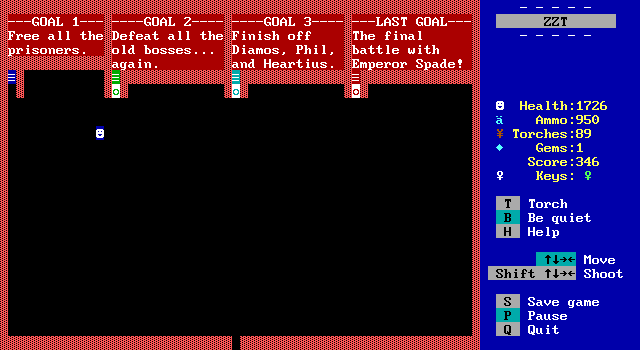
Goal 2 is a boss rush. Most of them weren't interesting enough to screenshot the first time I fought them, and it certainly isn't worth getting into now. I did take a fair amount of damage against Heartius and the Guardian of Mt. Gamewriter, since they don't have monologues to interrupt before their star barrages this time. Good thing Health is no object in this game.
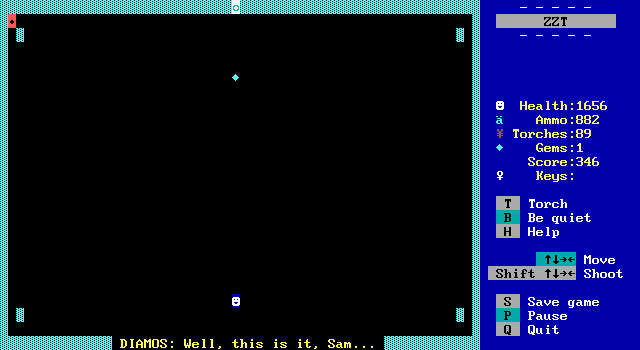
Goal 3 is the final showdown with Diamos, Phil the Club, and Heartius. Yes, we just fought them all in the boss rush, but those were the earlier versions from the secret hideout. These are new encounters, where their existing gimmicks have been tweaked and upgraded somewhat. For instance, Diamos' weakness now must be touched once in each corner of the board.
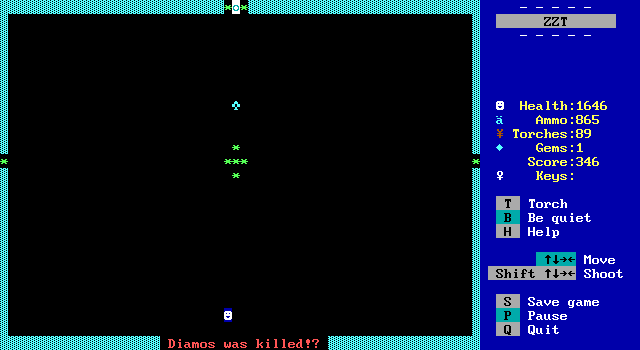
And Phil... has a few more ricochets in his room? He also takes more hits to be defeated.
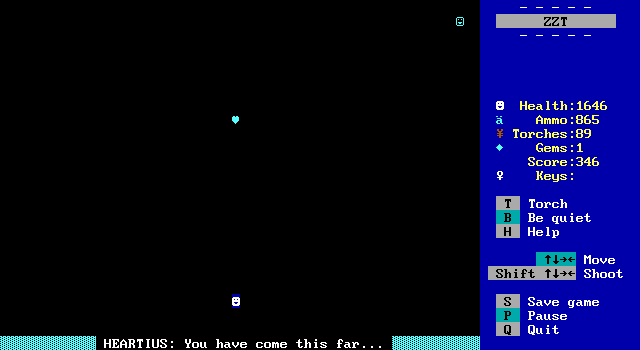
Heartius, by contrast, is a significant downgrade. He no longer shoots or throws stars at all; instead, his attack pattern is simply to walk up to Sam and touch him directly. Furthermore, the touching harms Heartius, not the player. The player can simply hold still, and this version of Heartius will defeat himself. Sam calls him a wimp one more time upon winning, and this time it's a more accurate label. That prisoner in the corner is there just to explain Heartius' gimmick, but Heartius will bump into the player and kill himself long before the player can make it up there, making this tutorial irrelevant.
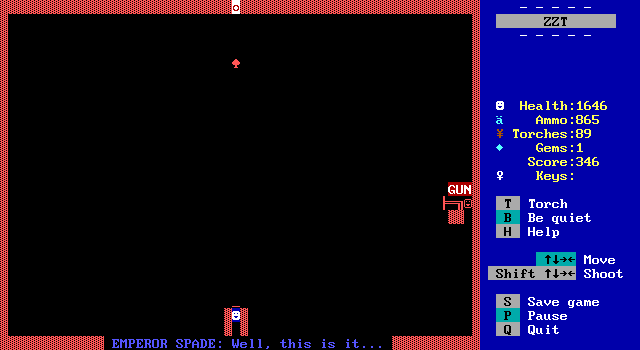
At last, the final showdown with Emperor Spade. Sam asks where the ZZTeam is, to which Spade declares that Sam is the hero of this game and heroes are always supposed to take on the villain one-on-one. Spade is a follower of the rules to the very end, which really does not change my previous assertion that the Card Empire is more sympathetic than the ZZTeam.
Mechanically, the final battle is yet another idea stolen from Sewers, in which the player can't shoot but can control other objects that shoot for them. In Sewers, the hero's party was all there (the equivalent would be if the ZZTeam were anywhere to be found on this board,) and touching any of them made them lunge forward and shoot away from the player. Here, the "GUN" object throws stars at the player until its operator is dispatched (done by simply touching him,) at which point the barrel shoots toward the left whenever Sam touches the trigger object on the right. If done quickly, Spade should be lined up in front of the barrel and shot until defeated with little difficulty. Of course, if the player does not understand this mechanic and lets Spade walk too close, leading him back into the barrel's trajectory is cumbersome at best.
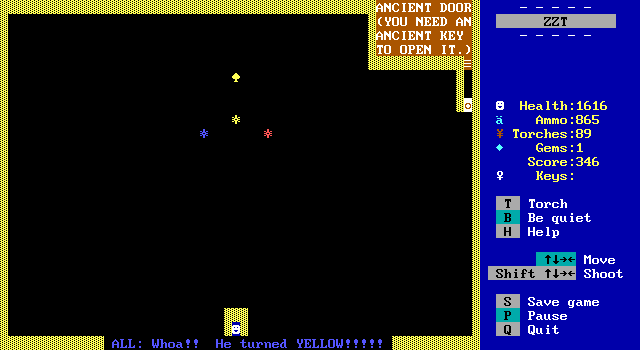
Spade isn't finished yet! He has a new form, and introduces himself as NEO-SPADE, who is completely invincible. ChocoboKick points out one obvious weakness, though: Spade (or Neo-Spade) is in ChocoboKick's game. ChocoboKick momentarily disappears, to "enter the programming room," and rewrites the ending so that Spade dies of a sudden heart attack. I ripped off so many other things in this game (mostly Sewers,) why not have a little Monty Python in there as well?
Spade dies with a big "NNNOOOOOOOOOO!!" that appears one letter at a time, which is an effect I learned from--you guessed it--Sewers. Except that Sewers' author had access to the #cycle command, so the letters at least appeared somewhat more quickly.
With the Card Empire gone for good, it's all over. Xaq asks if he can kill Sam yet, and ChocoboKick replies that he has a better idea: how about giving Sam the Ancient Key? Both of them give malicious evil grins and snicker openly as they do so, so no points for guessing that this is going to be a trap.
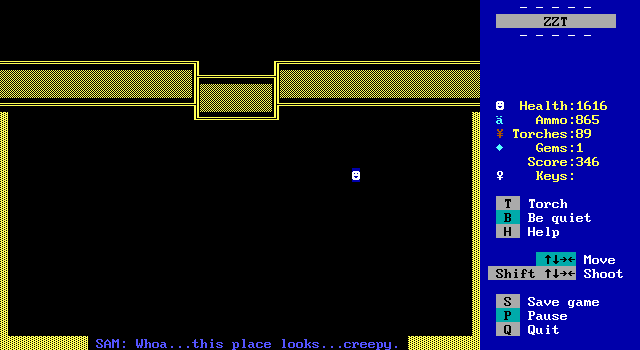
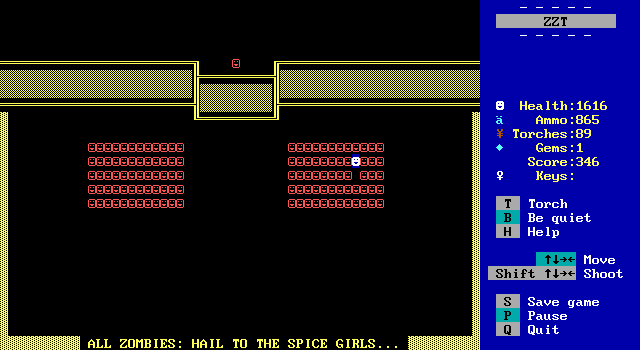
Oh.
This game doesn't have Barney in it, but it ends with the Spice Girls instead. This was probably due to personal experience: no one in my family watched Barney, so I wasn't exposed to him long enough to hate him as much as other ZZTers did. However, my sister was hugely into the Spice Girls, which made them a far more personal grudge of mine.
The zombies deploy the Hyp-no-Matic, which will transform Sam into a mindless zombie that worships the first non-zombie entity he sees. Which, of course....
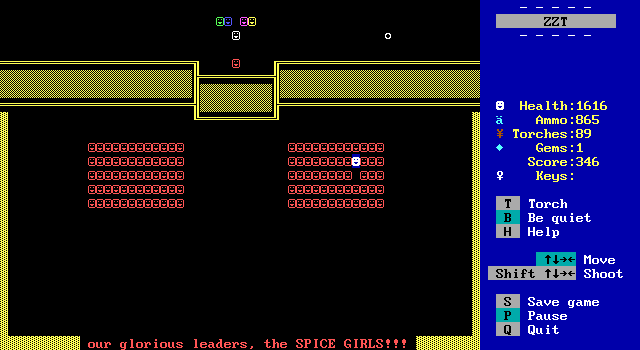
Things are not looking good for our hero.
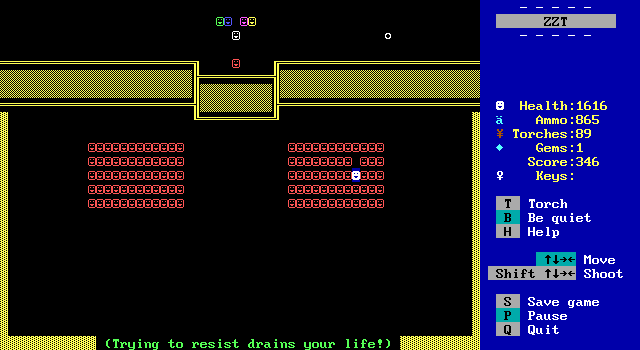
There is quite a lot of Health to drain, but there's nothing the player can do but wait for it to finish. This is it. There is no escape.
There is no real ending, either; the game takes Health 10 at a time to make the draining process go faster, but it has no code for what to do when the player doesn't have that much. If the player's Health is a multiple of ten, then the last tick should reduce the player to exactly 0, and trigger a standard Game Over, which serves as this game's ending. Instead, it drained me down to 6 Health and then just sort of stopped, because it had no code for what to do if the player has under 10 Health yet is still alive. This left me with no option but to manually quit the game.
I know I wasn't a very competent programmer back then, but I honestly cannot believe that I didn't catch this bug. I could have sworn there was an actual ending, even if it was a downer "and then Sam was a zombie" one, but I examined this board's code very closely and... no, this is it. It really does just drain the player's Health to 0 and Game Over them, and it doesn't even do that in a way that reliably works.
The intended ending, with a little imagination to discern what the game meant, is that the uneasy alliance between Sam and the ZZTeam is now broken. With the Card Empire slain and the game finished, Sam has outlived his usefulness. The ZZTeam led him through the Ancient Door, giving them one last laugh over their perceived nuisance. Sam struggles, but either dies or succumbs to a twisted unlife as a Spice Girl Zombie. Hooray! We're so glad and grateful to you for playing this game, and we hope you enjoy your well-earned reward.
Closing thoughts:
Adventure of Sam was never in the ZZT community's library. By the time I had even discovered the community, I'd already grown enough to change my name (to Kjorteo, at the time) and completely disavow this game. Even if I had tried to submit it, it would not have been accepted due to the lack of STK colors. Dos mentioned in his article on School ZZT that the 10 KB and STK requirements were there to keep other titles like School ZZT out, and he lamented some of the more competent titles that were lost as collateral damage to that rule. This is not one of those titles. This is exactly the sort of game they were envisioning when they made that rule, and its exclusion is nothing more than the rule working exactly as intended.
I'm still not proud of Adventure of Sam, in case this article did not make that obvious. Were the ZZT community still active, I still would not try to put something like this on it. Until the Worlds of ZZT and Museum of ZZT projects came along, I was very happy to let this game rot in the forgotten dustbin of ZZT history.
Then the Patreon hit its anniversary, the Museum launched, and Dos sent out that plea urging supporters to come forth with their old shame. He was right, and his words moved me.
This still isn't a good game, but in the Museum of ZZT, being a good game isn't the point. It doesn't have to be good to be historically significant. Yes, Adventure of Sam (by virtue of not actually being posted to the community) never had the impact that, say, School ZZT had. However, it was important because it was something that practically defined my character when I was a community member.
I had always wanted to remake Adventure of Sam. I wanted to go back and do it again with better programming, STK, and a bit less teenage edge. I would still be in it, but I'd be by myself, and I'd be far, far less of a horrible jerk to the player, for example. This project languished for several reasons (which I may get into in another article) but it was always there on my to-do list, and in the community's announced upcoming projects.
Yes, Adventure of Sam exists only as a horrible newbie game, a sequel that's also a horrible newbie game, and countless abandoned efforts that all would have been either Adventure of Sam 3 or the Adventure of Sam reboot. However, Adventure of Sam exists.
This was one of my defining characteristic in the fora. If I was known for one thing... well, okay, if I was known for one thing, it would be the Spicy Page, that pornographic gallery in my personal website whose phrasing in the warning disclaimer was somehow hilarious to everyone else. If I was known for two things, though, it would be the Spicy Page and being the Adventure of Sam guy.
I may release Adventure of Sam 2 to the Museum at some point in the future--much like Adventure of Sam 1, I'm a little too embarrassed to do so without an article like this explaining and apologizing for it first, and that will take time to write. I may even venture into the unreleased stuff, if these go well and there's any actual interest. For now, though, all I can really do is echo Dos's plea, the one that inspired me to write this:
We all did some embarrassing things when we were younger. Dos streamed Virus 302 and wrote a Closer Look article about its Special Edition remake. He then wrote a Closer Look article about School ZZT, the arguable worst ZZT game ever made. These things aren't preserved because they're worth playing, but because they're worth knowing about. School ZZT changed the ZZT community's history, and if its author had opted to exclude it from the Museum, then we wouldn't have a large piece of the puzzle that helps us understand how we got to where we find ourselves today.
So please, if Dos can post Virus 302, and I can post Adventure of Sam, then you can post whatever shame you're hiding in your old neglected ZZT folder. We want to see it. We want to understand not only what ZZT was, but who its users were. This is a story about young lives, about growing up through awkward adolescence. A game--even a bad one, perhaps especially a bad one--is a window to the mind of its creator as its creator existed back then. It's a glimpse of the creator's life and culture, of their personal likes and dislikes, of what was important to them. (Seriously, the Wonder Years theme, of all things?) This is fascinating and valuable information. I urge anyone reading this to come forward with who they were and what their games meant to them. We need as many vantage points as we can get if we're to understand the localized cultural phenomenon that is ZZT.


